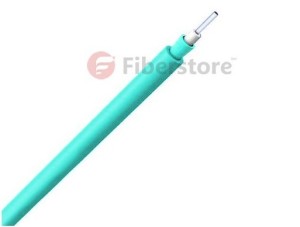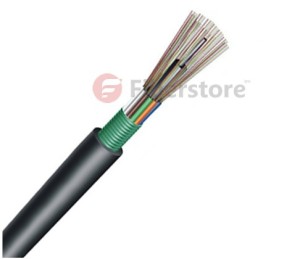Nowadays as we know, Fiber Optic Cable can eliminates the problem of twisted pair, such as the near-end crosstalk (next), electromagnetic interference (EMI), and security vulnerabilities to support high-speed data communications. It is difficult to make the right decision when it comes to data network cabling, because it can make a huge difference in your network that can reliably support current and future needs. We have many factors to consider and now I will introduce different optic cables and then you can find the suitable ways through it.
Single-Mode Fiber Cable and Multimode Fiber Cable
Single-Mode fiber cables include a tiny core that 5 to 10 microns, its function is eliminating distortion and producing higher transmission speeds. Single-Mode fiber optical fiber need laser technology to send and receive data. Single-Mode has the ability of carrying a signal for miles and it can apply to long haul or extreme bandwidth and it’s transmission rate can reach to 50 times more distance than Multimode but at the same time its cost more.
Multimode fiber optic cables, as its name, it allows the signal to travel in multiple modes, It is available with fiber core diameters of 62.5 and a slightly smaller 50 microns. The distances of Multimode fiber cables are that long cable runs in multiple paths may lead to signal distortion, it results in not clear and not completely data transmission. Multimode fiber cables can be used in applications covering short distances, the best function is data center connections. Multimode fiber cables is the economical choice in these applications, there are different kinds of performance levels within Multimode fiber cables, such as OM3 fiber optic cable for distances within 300m, OM4 fiber optic cable supports Gigabit Ethernet distances within 550m and 10G applications.
Indoor Fiber Optic cable Or Outdoor Fiber Optic cable
Indoor Fiber Optic cable are just that we called “tight-buffered” cables. the Indoor fiber cable has the features that flexible, and tough, containing multiple Tight Buffered or Unit Cord fibers. Available Indoor fiber cables have these types:
1. Simplex and Zip Cord: simplex fiber optic cables are one fiber and tight-buffered and it used for Indoor. Zip cord just only the two web of these joints, it is mostly used for patch cord and backplane applications but the Zip cord also can be used for desktop connections. There fiber optic cables who have one fiber are usually used Indoor.
2. Distribution cables: these fiber optic cables include several tight-buffered fibers bundled under the same jacket, the size is small and use for short. The fibers are double buffered and can be directly terminated, but because their fibers are not individually reinforced, these cables need to be broken out with a “breakout box” or terminated inside a patch panel or junction box. The distribution cable is smaller and used in dry and short conduit runs, plenum and riser applications, is the most popular cable for indoor use.
3. Breakout cables: These fiber optic cables are made of several simplex cables bundled together inside a common jacket for convenience in pulling and ruggedness. This is a strong and hard design, large but more expensive than the distribution fiber cables. It suits to conduit runs, riser and plenum applications, it is ideal fiber cables for industrial applications where ruggedness is important or in a location where only one or two pieces of equipment (such as local hubs) need to be connected.
The major difference between indoor and outdoor cables is water blocking. Any conduit is someday likely to get moisture in it.
Outdoor fiber cables are designed to protect the fibers from years of exposure to moisture.
Outdoor fiber optic cable need more protection from water ingress, vermin, and other conditions encountered underground and Outdoor fiber cable also need to increase strength for greater pulling distance. Buyer should know that cables will face with the potential hazards such as it will be exposed to chemicals or extreme temperatures.
1. Loose Tube cables: these fiber cables are inside small plastic tube, it provides a small, high fiber count cable. This type of cables is ideal for outside plant trunking applications, because it can fill with gel or water absorbent powder to prevent harm to the fibers from water. Since the fibers only have a thin buffer coating, they must deal with it carefully to protect it from damage. Is also can be used in conduits, strung overhead or buried into the ground.
2. Ribbon Cable: these fiber optic cables provides the highest packing density, because all the fibers are laid out in rows , and usually 12 fibers and put them on top of each other. Some fiber optic cable designs use a “slotted core” with up to 6 of these 144 fiber ribbon assemblies for 864 fibers in one cable! Since it’s outside plant cable, it’s gel-filled for water blocking.
3. Armored Cable: this Armored fibre cable installed by direct burial in areas where rodents are a problem usually have metal armored between two jackets to prevent rodent penetration. This means the fiber optic cable is conductive so it need to be grounded properly. You’d better choose armored fiber cable when use fiber optic cables directly buried outdoor.
4. Aerial Cable: these cable can be lashed to a another cable or messenger or it had metal or aramid strength members to make them self supporting. Aerial cables are for outside installation on poles.
Fiberstore is a reliable fiber optic cable shop, it provides different kinds of fiber optic cables you want, including all above what I mentioned in the article, and at the same time Fiberstore is doing with 30% discount of the price on fiber optic cables, then if you want to buy fibre optic cable(fiber optic cable), welcome to enter into our online store.


